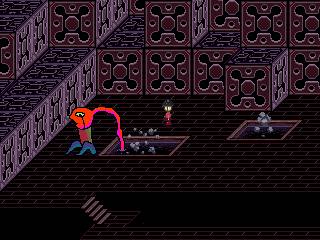 I miss the old internet. I miss the days when people had homemade personal websites that they coded themselves. It was like an exam you had to sit. If you couldn’t figure out HTML, too bad. Now every idiot is posting from a professionally designed tumblr template. The dissonance is chilling. Beautiful CSS3 compatible websites used as a delivery system for Socially Awkward Penguin memes.
I miss the old internet. I miss the days when people had homemade personal websites that they coded themselves. It was like an exam you had to sit. If you couldn’t figure out HTML, too bad. Now every idiot is posting from a professionally designed tumblr template. The dissonance is chilling. Beautiful CSS3 compatible websites used as a delivery system for Socially Awkward Penguin memes.
I liked it when forums weren’t locked down with karma and upvotes and approval scores and other tools designed to make you into a sheep. Once, you posted to express opinions. Now, you post like a politician. “How will my post play with the ‘upvotes Dr Who references’ crowd? Will it enrage the anti-Care Bears demographic? Oh shit, we’re losing the mandate!”
Tumblr is a horror and a human rights travesty on par with the Holocaust and the Bataan Death Marches. Just a nonstop stream of disparate information being fed at you with no organisation. Things appear. Then they disappear. If you have something to say on Tumblr, make sure you don’t waste too much effort typing it. By tomorrow morning it will have disappeared from everyone’s dash and nobody will remember it.
Once, creative people thought you could make money on the internet. Then, they thought you could build a fanbase on the internet. Even that is beginning to seem like a pipe dream. If you make a pretty picture, it might go viral…after some ass-pirate on Reddit swipes your picture, edits out your name, and claims it was drawn by his autistic 12 year old sister. I have no idea who created half the shit I see online. It seems that wanting to be credited for your work is an obsolete idea, like “Be Kind, Rewind!”
Youtube becomes measurably worse each year. Remember how once you could pause a video and it would buffer to the end? And how could you see video ratings in the sidebar? Why don’t we still have those things?
Nobody reads any more. Images are how we talk. If you want to get some of King George’s English in front of a mass audience, it needs to be bold, punchy, feature at least 3 colours, be in ALL CAPS, and be superimposed over a dramatic image emphasising your point. Make sure you use simple words.
The entire internet should be buttfucked with dynamite.
No Comments »
 Yume Nikki is so strange…and so familiar! It is everything games used to be but no longer are.
Yume Nikki is so strange…and so familiar! It is everything games used to be but no longer are.
When I say it’s like a classic adventure game, I don’t mean it’s like Escape from Monkey Island. It’s more like the odd and dissolute wave of adventure games that came out during the CD-rom revolution. In the early to mid 90s, publishers were hungry for CD-based games and released (in addition to a deluge of crappy knockoffs) quite a few experimental and anticommercial titles like Bad Mojo and I Have No Mouth and I Must Scream that normally would never have made it to store shelves.
Yume Nikki (made in RPGMaker 2003 by Kikiyama), is basic and minimal. You play as a reclusive girl who has dreams and then writes the dreams down in a diary. You have a small house to explore, and a bed to dream in. You access dreams via a central nexus point with twelve doors. Each of the doors takes you to a world so strange and so huge that you might never find your way back.
There’s no dialogue, and no obvious story. The game is free-flowing and open, and mostly consists of exploring strange and confusing lands beyond the veil of sleep. You can wake yourself up at any time by pinching your face. In the dream worlds there are items that can be collected, although many of them seem useless. The NPCs aren’t much help, either. Ultimately, you’re on your own, and you have to discover what purpose Yume Nikki has…or if it even has one.
You can see what creative well Kikiyama was drawing from here. The rudimentary graphics, soothing music, and “do whatever you want” gameplay synthesises into a game with a powerful and spellbinding atmosphere. Any deficiencies in content are remedied by your own brain. Needless to say, you can find numerous fan theories online “explaining” every little thing from the theories of Freud and Jung.
The game’s ending (if you’re able to find it) is surprising. I’ve only played one game that ends the way Yume Nikki does (Creative Reality’s 1994 game DreamWeb), although Yume Nikki colours the darkness with a bit of mystery. There is a small detail about the environment, easy to miss, that will cause you to rethink the ending and its implications.
But even the fact that it has an ending seems unimportant. It might have just kept on going forever. This isn’t a game you play, complete, and check off your Gamer’s Literary Card. It’s more of an interactive digital experience that has value only equal to the effort you put into it. Either way, it should be played. Yume Nikki a unique and eerie time capsule into gaming’s darkening past.
No Comments »
P ut a piece of paper on a table, draw a circle on it, and label the circle “Metal Bands that sound good with an orchestra.” Inside the circle write Manowar, Deep Purple, and others.
ut a piece of paper on a table, draw a circle on it, and label the circle “Metal Bands that sound good with an orchestra.” Inside the circle write Manowar, Deep Purple, and others.
Metallica would go outside the circle, on a different piece of paper, and on a different table.
Metallica songs categorically do not sound good with an orchestra. Either they’re thrash metal (pre 1991), a raw and minimalistic cousin of hardcore punk that is not noticeably improved by horn sections, or modern rock (post 1991) that, with a few exceptions, shouldn’t be performed live at all in any format.
You can hear the problems when the band farts their way through “Master of Puppets”. The orchestra and Metallica sound disconnected, like two jigsaw pieces with edges that don’t fit. Part of it is James’ dull Nickelback-sounding rhythm tone, but mostly it’s the song. “Master” has quite busy riffs, and the added symphonic swirls and vamps send it over the top. The famous clean section in the middle sounds like a garbled out of tune mess. There’s too much stuff here, all of it fighting for space.
Metallica has a decent stable of long progressive-sounding songs, and tracks like “The Thing That Should Not Be” and “Call of Ktulu” fare a little better. They also play a bunch of Load and Re-Load songs. They sound pretty bad, which is no surprise. Most of these songs were rubbish in their original incarnations. There are two new songs, cut from the Load template, with “Minus Human” being the more interesting of the two. The symphonic elements still clash. One Load song sounds better recorded like this, though. On disc, “Hero of the Day” was the worst Metallica song recorded up to that point. Here, it just sounds ridiculous and a bit funny.
The performance…underperforms. James’ voice is overly clean sounding, and he can’t bark or shout worth shit. Lars Ulrich is a perennial weak link in the band, although at this point he wasn’t yet setting records for the worst drum sounds ever recorded. Kirk continues laying down his trademark pentatonic shredding, but I wish he would leave the wah pedal alone. These symphonic songs would sound better with a less “expressive” approach to lead playing. If Metallica had recorded S&M in 1986 the effect would have been one of over-the-top excessiveness. But now, they sound tired. Not the kind of tiredness you fix with a nap. The kind of tiredness you fix with retirement. Why is this band still around? Almost everything they’ve recorded after 1991 is worthless.
S&M sounds like a Metallica cover band composed of balding 40 year old landscapers, playing a mixture of awesome classics and crappy modern hipster rock, with the venue accidentally double-booked with an orchestra for some reason.
No Comments »
 I miss the old internet. I miss the days when people had homemade personal websites that they coded themselves. It was like an exam you had to sit. If you couldn’t figure out HTML, too bad. Now every idiot is posting from a professionally designed tumblr template. The dissonance is chilling. Beautiful CSS3 compatible websites used as a delivery system for Socially Awkward Penguin memes.
I miss the old internet. I miss the days when people had homemade personal websites that they coded themselves. It was like an exam you had to sit. If you couldn’t figure out HTML, too bad. Now every idiot is posting from a professionally designed tumblr template. The dissonance is chilling. Beautiful CSS3 compatible websites used as a delivery system for Socially Awkward Penguin memes.

